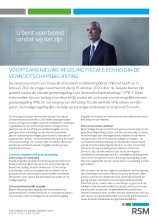On February 11, 2021 the State Secretary for Finance Vijlbrief provided a response to the questions relating to the “new group consolidation regime in the Dutch Corporate Income Tax (“CIT”) as asked by the House of Representatives on October 15, 2020. These answers are of importance because they provide more clarity to the proposed new CIT consolidation regime, which is to replace the current CIT fiscal unity regime. The viability of the current system has been put into question following a decision by the European Court of Justice that some aspects of the current CIT fiscal unity regime seem contrary to EU law.
Background; the response is a direct consequence of the public consultation which took place in 2019, were business and knowledge representatives participated. As a result of the public consultation four alternative solutions were formed, of which the so-called “profit/loss transfer system (including system of pooling of results)” was given preference. Outlined below are the important aspects of the new group consolidation regime.
Aspects new group consolidation regime
Stand-alone approach
From a practical perspective, each entity of the group consolidation regime will need to determine the tax position on a stand-alone basis (stand-alone approach). Afterwards the results of all the participating entities will be consolidated. This is a substantial difference with respect to the current CIT fiscal unity regime.
Loss settlement still possible
Like the current fiscal unity regime, within the new group consolidation regime, it is still possible to off-set profits and losses between different member of the group.
Internal transaction visible
The current CIT fiscal unity regime provides a tax-free transfer of assets when there is an intra-fiscal unity transfer or an internal reorganization between group members. The main reason is that the results of the subsidiary companies are included in the results of the parent company for Dutch CIT purposes, neutralizing all intra-group trans-actions. Contrary to EU law, this aspect of the CIT fiscal unity regime – also known as profit consolidation - will not be part of the new group consolidation regime. As stated before all entities should separately determine their tax position.
As a result of the abolishment of the profit consolidation scheme, transactions between group member will become visible for CIT purposes. For instance the transfer of assets within the group, as opposed to the current treatment, will no longer be tax-free based on the fiscal unity facility. Consequently, any realized profits on such assets trigger a (earlier) taxable event for CIT purposes. It remains to be seen whether a new reorganization facility will be introduced, alongside the already existing facilities.
Requirements and applicability
With respect to the requirements to be included in the new group consolidation regime, it is proposed to maintain the current CIT fiscal unity requirements, whereas the same type of entities will have access to the new group consolidation regime, as is currently the case for the fiscal unity regime. The same shareholding of 95% should apply in order to create a new consolidation group. Furthermore, the requirements for termination are expected to be similar to the current fiscal unity termination requirements.
However, It remains unclear whether creating a new consolidation group should be compulsory when the requirements are fulfilled, or that it should remain an option. Preference seems to be given to the group consolidation being an option rather than compulsory (as is the case for the current fiscal unity regime).
Abolishment current regime
It is expected that various complex rules in the current CIT fiscal unity regime will be abolished or will be simplified when applying. For instance the abolishment of the complex profit-splitting rules for loss compensation, the compensation of provisional liquidation losses, the compensation of carry-forward of non-deductible interest under article 15b CITA (earnings-stripping rule), the abolishment of the anti-abuse provisions for intra-group transfer of assets i.e. article 15ai CITA, but also the rules with respect to losses in the case of entities that exit the CIT fiscal unity.
Current regime for a minimum of five years
As the incorporation of the new group consolidation regime in Dutch law is an extensive, drastic and without a doubt complex subject, it is expected that a minimum of 5 years will be needed for the new rules to become effective. Until that time the current fiscal unity regime will still be in force, bearing in mind that some aspects of the existing system, even after the introduction of the emergency response legislation, would still appear to be in conflict with EU law.
More information?
Should you have any question with respect to the possible impact of the abovementioned, please contact your trusted RSM advisor.
Download 'update new CIT group consolidation regime' in pdf

